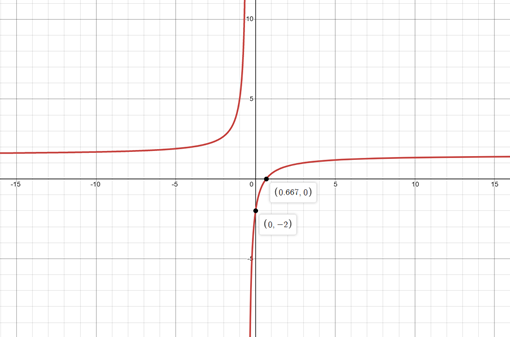
Concept explainers
To find the asymptotes and holes of the function
Answer to Problem 66E
Explanation of Solution
Given:
Function:
Calculation:
Intercepts:
Let
To find x intercepts, put y = 0,
So, x intercept is (0.667, 0).
To find y intercepts, put x = 0,
So, y intercept is (0, -2).
Asymptotes:
Vertical asymptotes:
To find vertical asymptotes, put denominator of the given function equal to zero.
Horizontal asymptotes:
As the degree of numerator is equal to the degree of the denominator, the horizontal asymptote is
Slant asymptotes:
As the degree of numerator is equal to the degree of the denominator, the slant asymptote does not exist for given function.
Holes:
Here, the given function contains one common factor in numerator and denominator i.e..,
To find hole of the function, equate common factor equal to zero.
So, the hole of function is
Calculation for graph:
Consider
| Values of x | Values of f (x) |
| 0 | -2 |
| 1 | 0.333 |
| -1 | 5 |
| 2 | Undefined |
| -2 | 1.1818 |
By taking different values of x, the graph can be plotted.
Graph:

Interpretation:
By observing graph, it is clear that
The x intercept is (0.667, 0),
The y intercept is (0, -2),
The vertical asymptotes are
The horizontal asymptote is
Chapter 2 Solutions
EP PRECALC.GRAPHING APPR.-WEBASSIGN-1YR
- Find the accumulated amount A, if the principal P is invested at an interest rate of r per year for t years. (Round your answer to the nearest cent.) P = $3800, r = 4%, t = 10, compounded semiannually A = $ 5645.60 × Need Help? Read It SUBMIT ANSWER [3.33/6.66 Points] DETAILS MY NOTES REVIOUS ANSWERS ASK YOUR TEACHER TANAPCALC10 5.3.001.EP. PRACTICE ANOTHER Consider the following where the principal P is invested at an interest rate of r per year for t years. P = $3,100, r = 4%, t = 10, compounded semiannually Determine m, the number of conversion periods per year. 2 Find the accumulated amount A (in dollars). (Round your answer to the nearest cent.) A = $ 4604.44arrow_forwardForce with 800 N and 400 N are acting on a machine part at 30° and 60°, respectively with a positive x axis, Draw the diagram representing this situationarrow_forwardI forgot to mention to you to solve question 1 and 2. Can you solve it using all data that given in the pict i given and can you teach me about that.arrow_forward
 Calculus: Early TranscendentalsCalculusISBN:9781285741550Author:James StewartPublisher:Cengage Learning
Calculus: Early TranscendentalsCalculusISBN:9781285741550Author:James StewartPublisher:Cengage Learning Thomas' Calculus (14th Edition)CalculusISBN:9780134438986Author:Joel R. Hass, Christopher E. Heil, Maurice D. WeirPublisher:PEARSON
Thomas' Calculus (14th Edition)CalculusISBN:9780134438986Author:Joel R. Hass, Christopher E. Heil, Maurice D. WeirPublisher:PEARSON Calculus: Early Transcendentals (3rd Edition)CalculusISBN:9780134763644Author:William L. Briggs, Lyle Cochran, Bernard Gillett, Eric SchulzPublisher:PEARSON
Calculus: Early Transcendentals (3rd Edition)CalculusISBN:9780134763644Author:William L. Briggs, Lyle Cochran, Bernard Gillett, Eric SchulzPublisher:PEARSON Calculus: Early TranscendentalsCalculusISBN:9781319050740Author:Jon Rogawski, Colin Adams, Robert FranzosaPublisher:W. H. Freeman
Calculus: Early TranscendentalsCalculusISBN:9781319050740Author:Jon Rogawski, Colin Adams, Robert FranzosaPublisher:W. H. Freeman
 Calculus: Early Transcendental FunctionsCalculusISBN:9781337552516Author:Ron Larson, Bruce H. EdwardsPublisher:Cengage Learning
Calculus: Early Transcendental FunctionsCalculusISBN:9781337552516Author:Ron Larson, Bruce H. EdwardsPublisher:Cengage Learning





